Comparing 7 iPhones: Battery (Part 1 of 2)
Posted by Wesley on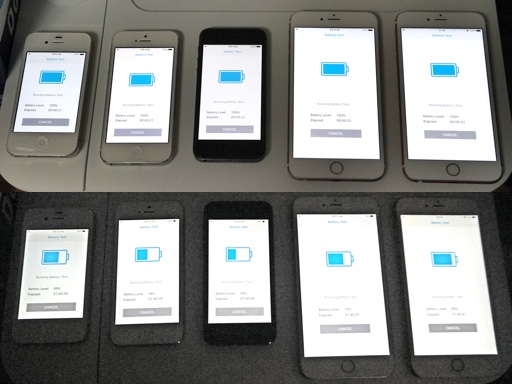
iPhone 4S, 5, 5S, 6+, and 6S+ running GeekBench 3 battery test
Battery life is something most smartphone users take a big interest in, sometimes more than the raw performance. What good is a fast phone if you can't use it long enough without recharging? For iPhones, this is especially important because you can't swap out the battery without disassembling. So I decided to test this as the time allowed.
Now, each of my iPhones had been used for wildly different lengths of time, so the level of remaining battery capacity would be different as a result. This would obviously affect the tests, so I checked the capacity using iBackupBot, as you can see here.
| Device | Design (mAh) | Actual (mAh) | Ratio |
|---|---|---|---|
| iPhone 6S+ | 2725 | 2800 | 102.8% |
| iPhone 6+ | 2855 | 2800 | 98.1% |
| iPhone 5S | 1550 | 1400 | 90.3% |
| iPhone 5 | 1430 | 1400 | 97.9% |
| iPhone 4S | 1430 | 1300 | 90.9% |
| iPhone 4 | 1420 | 1347 | 94.9% |
| iPhone 3GS | 1200 | 1075 | 89.6% |
Fortunately, batteries were mostly in good condition, having 90% or more capacity left. The brand new iPhone 6S Plus actually had slightly more than it should. Still, the difference is non-negligible. So the results of my battery tests would be normalized to the design capacity to make the comparisons fair. The 6S Plus results would be lowered a bit while the others would be boosted, all according to their respective ratios.
For a heavy-load scenario like playing a game, I used the battery test included with GeekBench 3. This is available for version 3.3 and higher, so iPhone 4 and 3GS, which can only run lower versions, had to be left out. With this test, airplane mode was turned on and the low power mode was turned off. To see how much effect the display backlight has, the test was run with both lowest and highest brightness settings.
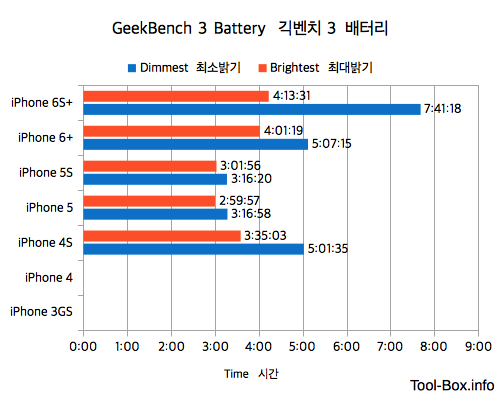
Normalized battery duration of the iPhones measured by GeekBench 3
| Screen | iPhone 4S | iPhone 5 | iPhone 5S | iPhone 6 Plus | iPhone 6S Plus |
|---|---|---|---|---|---|
| Dimmest | 04:34:10 | 03:12:50 | 02:57:20 | 05:01:20 | 07:54:00 |
| Brightest | 03:15:30 | 02:56:10 | 02:44:20 | 03:56:40 | 04:20:30 |
With the screen brightness lowered, iPhone 6S Plus pulls ahead of all other previous generations. It's an impressive feat, beating the 6 Plus at the second place by about two and a half hours. The gap significantly narrows with full brightness, but it still manages to stick around slightly more. Considering that this is done with 5% less design capacity, it's certain that the 6S Plus is quite efficient despite all the enhanced performance.
Meanwhile, the battery capacity of the Plus series is so large that it has enough power left over even after driving a bigger backlight and much more screen pixels. Overall, the Plus series lasts noticeably longer than the predecessors. Curiously, the 5 and 5S don't show much difference in regards to the screen brightness compared to the other models. It seems the characteristics of the screen used for these devices were different.
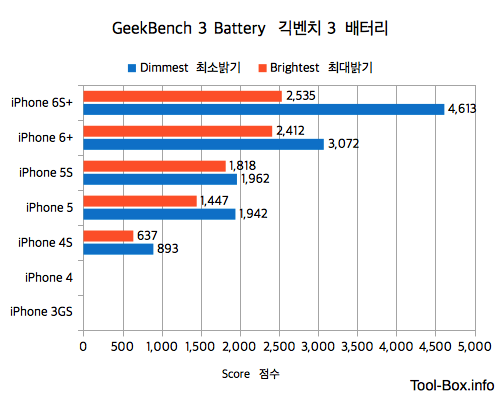
Normalized battery score of the iPhones measured by GeekBench 3
There's another aspect to GeekBench 3's battery test. It gives out a score based on how much work the device was able to do as the battery was drained. If a device is faster than the other but lasts the same, the score would be higher.
And as expected, the scores increased as you move up each generation. It doesn't completely correlate to GeekBench's performance scores, but you can still see the trend. For an example, 6 Plus scores much higher than 4S despite having similar endurance.
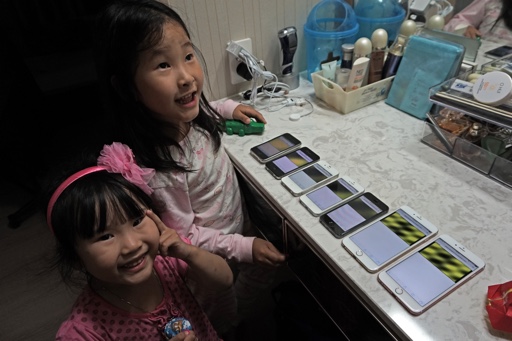
Celine and Hayun comes to see the PeaceKeeper battery tests
Now I wanted to test battery life with web browsing involved. I found that the web browser benchmark PeaceKeeper had an option to run continuously for a simple battery test, so I decided to try this. The benchmark isn't as taxing as GeekBench, but it does push the web browser around to make it do all sorts of things as it loads each page. So the measured time from this would be sort of an upper bound for a web browsing session.
Another plus side of this test is that it runs on 3GS and 4 as well. It isn't perfect, though. A few unsupported tests are skipped, so the workload is expected to be somewhat lighter. In a way, though, it's reflective of the web that someone using those devices would experience, so the results would still be meaningful.
To make the test conditions equal, the Airplane Mode was turned off, but the SIM cards were removed so that only Wi-Fi was used for loading web pages. Also, GPS was on and the screen brightness was fixed at 50%. During the testing, my daughters came to look at the pretty colours that the screens were lit up with, but they didn't touch anything and didn't affect the results.
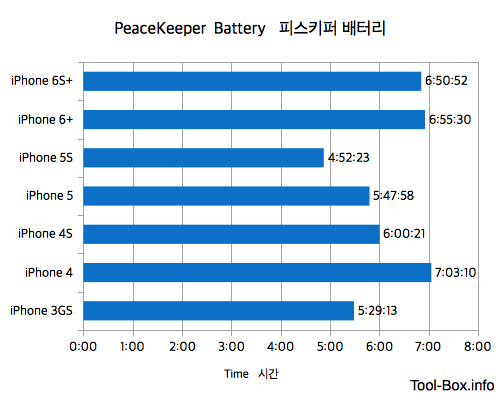
Normalized battery duration of the iPhones running PeaceKeeper benchmark
Again, 6 Plus and 6S Plus do much better compared to the devices running the same iOS version. A little surprise is that 5S ended up doing a bit worse than expected even after normalization, since it was behaving quite similar to 5 with the GeekBench test.
Looking at the pre-iOS 9 devices, iPhone 4 managed to post similar time as the Plus devices. This is likely due to not being able to run tests like WebGL. It still means that it gets good battery times browsing the web in general. 3GS is showing its age, though. Even with the advantage of having least tests to run, it managed notably worse than 4.
Taking all these results together, I can surmise that the battery performance had been steadily improving up to 4S, then stagnated at the 5 & 5S. With the enlarged Plus series the battery time took another jump. Apple seems to have made sure that the user gets good enough battery time under normal circumstances during all these years. Large-screened devices tend to be used more, so the extra battery time may be a smart move and perhaps even intentional.
Defined tags for this entry: battery, Geekbench, iPhone 3GS, iPhone 4, iPhone 4S, iPhone 5, iPhone 5S, iPhone 6 Plus, iPhone 6S Plus, PeaceKeeper